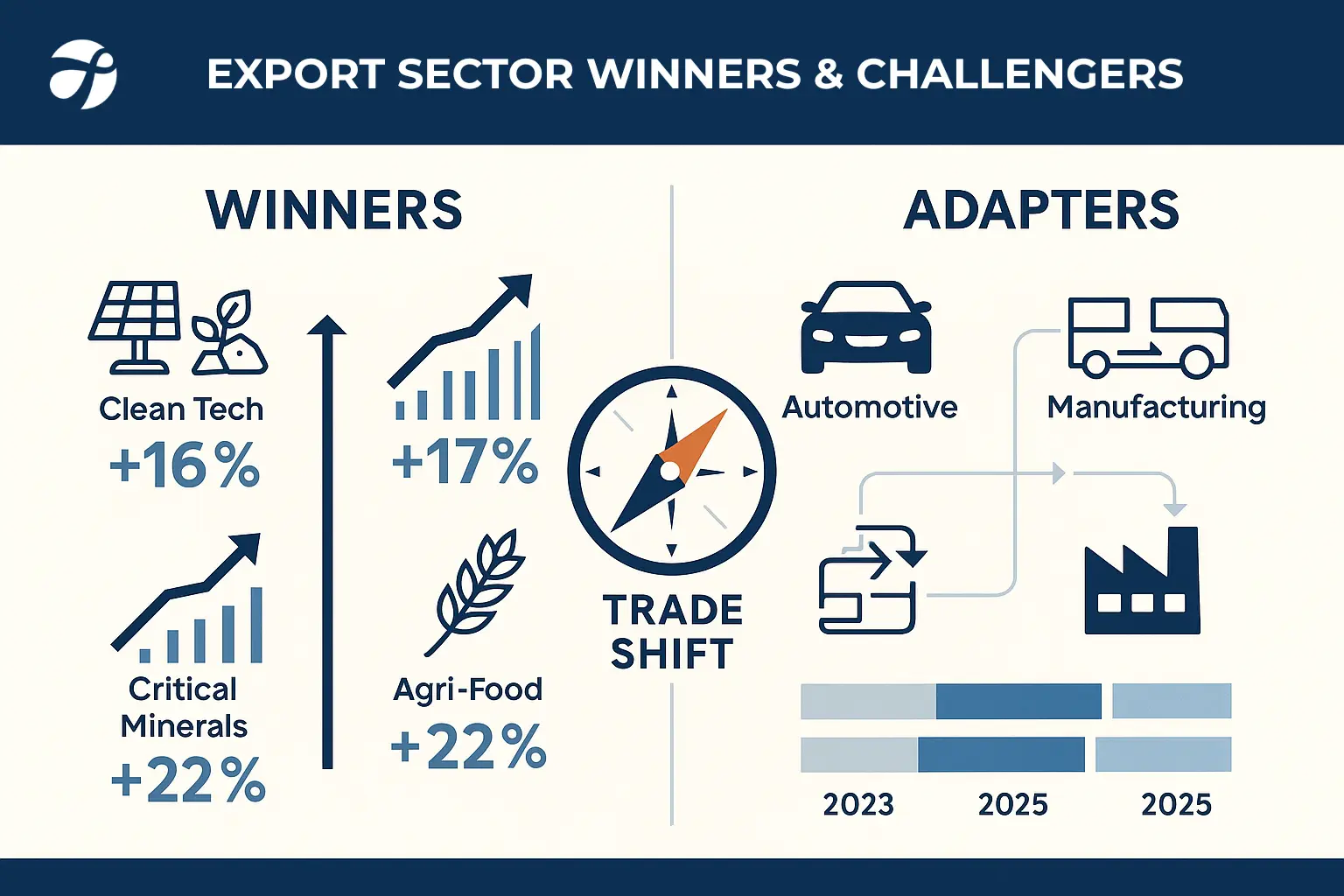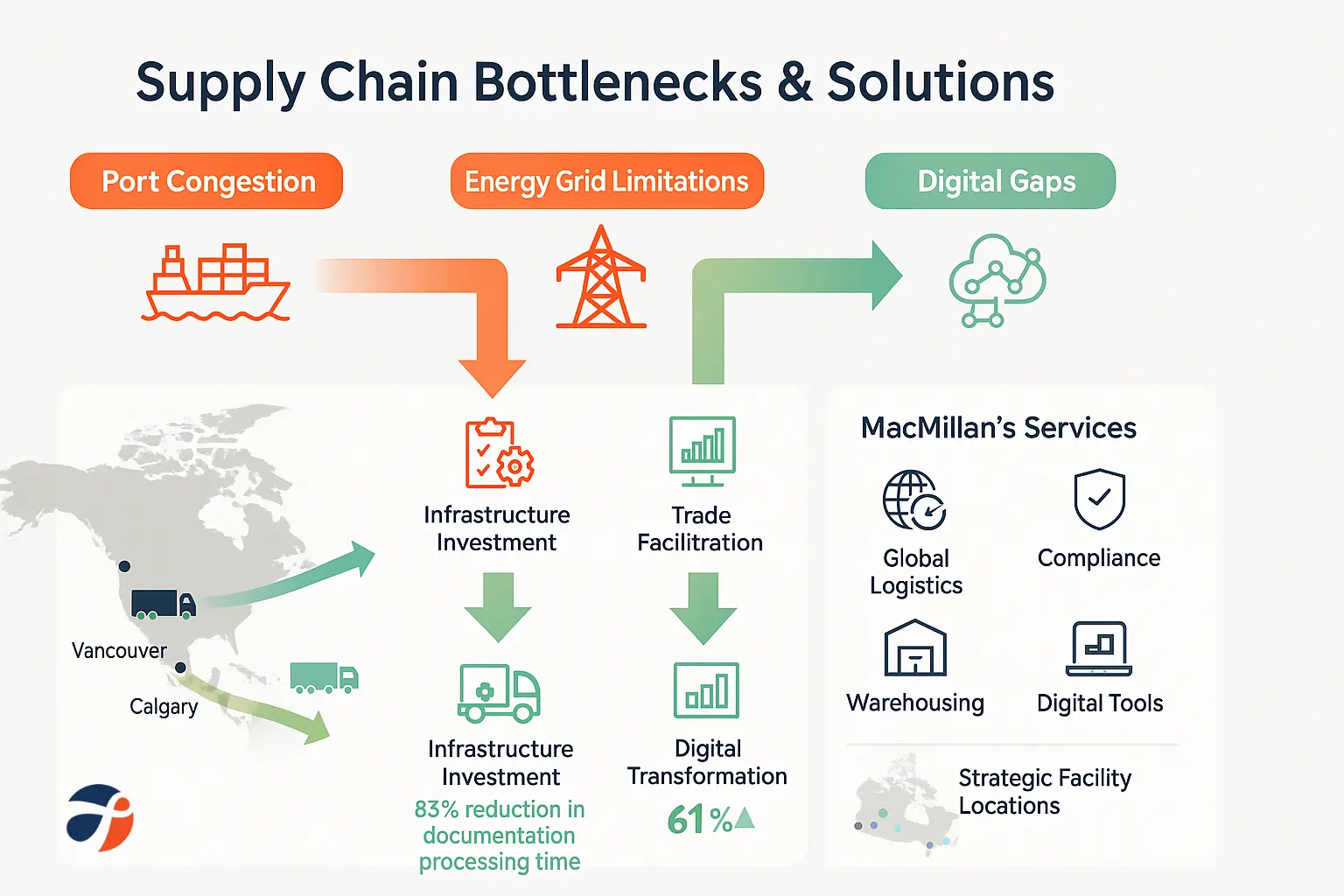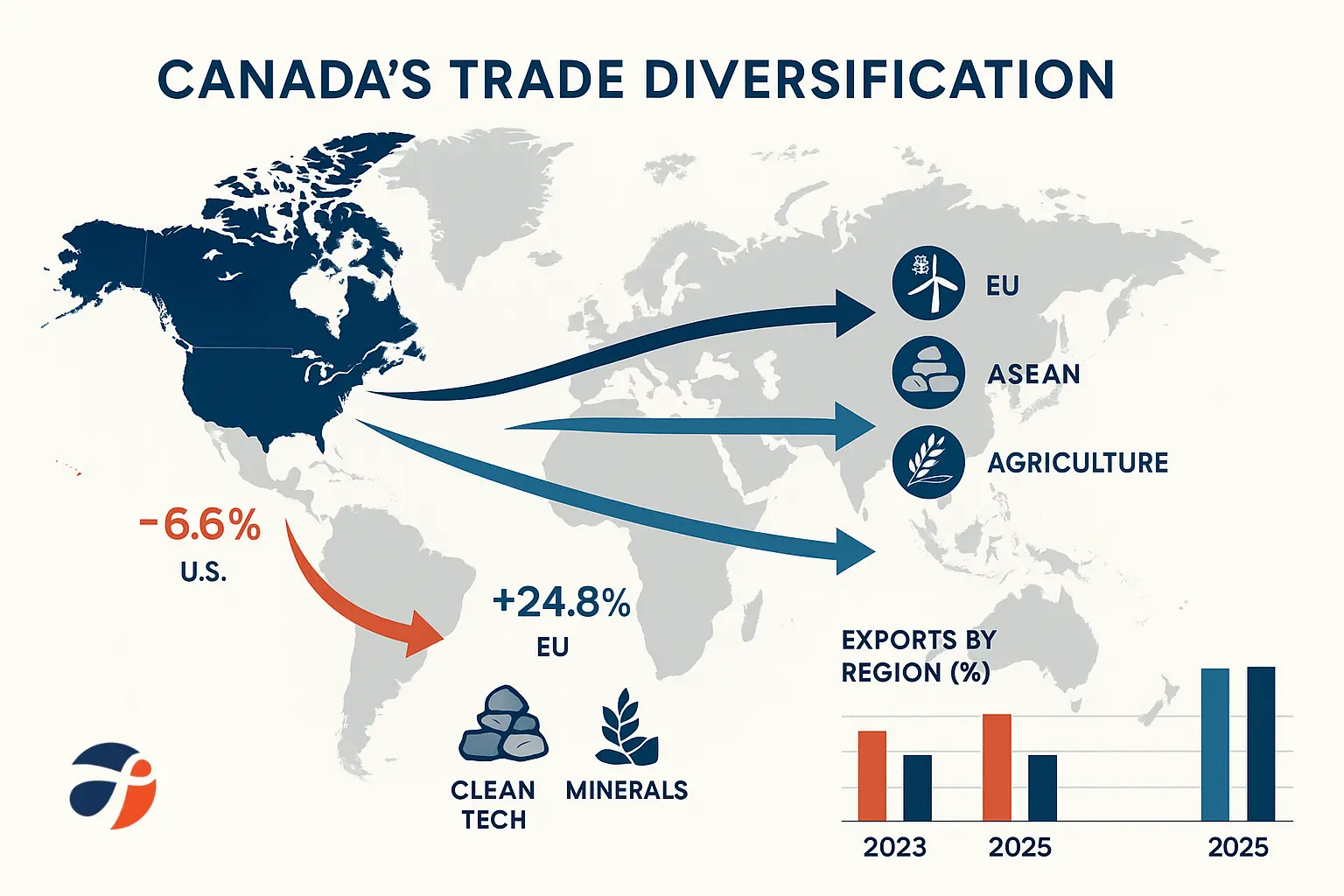Canada’s trade is changing dramatically, moving away from its previous export strategy that was centered on the United States. According to recent data, exports to the US have decreased 6.6%, while exports to the EU and ASEAN have increased by 24.8% and 11.2%, respectively. Tariff tensions are speeding up this change, which is changing supply chains and opening up new markets in industries ranging from critical minerals to clean technology. Leading this shift is MacMillan Supply Chain Group, which offers the logistics know-how required to successfully negotiate new international markets and support the Canada trade shift away from the U.S.
Why Canada’s Trade Landscape Is Changing
With about 75% of exports going south of the border, Canada’s economic success has long been closely tied to U.S. trade relations. For Canadian businesses, this dependence put them in a precarious but comfortable position. When new tariffs were placed on Canadian steel (25%) and aluminum (10%) as well as other agricultural products, the comfort came to an abrupt end.
Economists refer to the ensuing trade tensions as a “forced diversification” because they have compelled Canadian exporters to investigate markets they had previously disregarded. This article explores how this Canada trade shift away from the U.S. is occurring, which industries are reaping the benefits, what obstacles still exist, and how logistics partners like MacMillan Supply Chain Group are helping to bring about this momentous shift to more equitable international trade relations.
The Catalyst: U.S. Tariffs and Their Immediate Impact on Canada Trade Shift Away from the U.S
Canada’s export environment has been drastically changed by the recent wave of U.S. tariffs. Exports to the US fell 6.6% in March 2025, costing numerous industries billions of dollars in lost revenue. Crude oil (-8%), machinery (-7.3%), and auto parts (-12%) are the industries most severely impacted.
It took some time for these tariffs to appear. They signify a sharp rise in trade tensions that started years earlier but reached a new level in 2024. Section 232 tariffs on aluminum and steel, which were defended on the grounds of “national security,” were only the first step. Expanded tariffs on agricultural products like pork (35%) and automobiles with insufficient North American content (25%) followed shortly after.
Canada didn’t do nothing. Targeting politically sensitive U.S. goods from important states, the government imposed strategic counter-tariffs on Wisconsin dairy machinery (15%), Kentucky bourbon (25%), and Florida citrus (22%). Although necessary, this tit-for-tat strategy demonstrated that diversification was not only desirable but also crucial for maintaining economic stability.
“When your largest trading partner becomes unpredictable, you don’t just need a Plan B – you need Plans C, D, and E,” notes a senior trade analyst at Export Development Canada. “That’s exactly what we’re seeing Canadian businesses implement now in response to the Canada trade shift away from the U.S.”
 New Horizons: Where Canadian Exports Are Finding Success Amid Canada Trade Shift Away from the U.S
New Horizons: Where Canadian Exports Are Finding Success Amid Canada Trade Shift Away from the U.S
With impressive results, Canadian exporters swiftly shifted to other markets as U.S. trade declined. With Canadian exports rising 24.8% in March 2025 over the previous month, the European Union was the main beneficiary of this change.
Throughout this transition, the Comprehensive Economic and Trade Agreement (CETA) between the EU and Canada has shown its value. After 98% of tariffs were removed, Canadian companies discovered ready markets for:
Exports of gold to the UK (+32%)
Crude oil exports to the Netherlands (+28%)
Pharmaceutical ingredients shipped to France and Germany (+19%)
Lithium and other essential minerals for EU battery producers (+17%)
With exports to ASEAN countries increasing 11.2%, Southeast Asia has also become a crucial growth market. With Canadian agri-food exports up 23% and clean tech components up 16%, Thailand has grown in importance.
Since its opening in early 2025, the Export Development Canada (EDC) office in Bangkok has helped close more than $100 million in transactions. The $12 million deal signed by Vancouver-based Terramera to provide biopesticides to Thai agribusinesses is an example of the new prospects that are opening up in these markets.
Building more robust supply chains that can endure future geopolitical shocks is the goal of this geographic diversification, not merely replacing lost U.S. sales—truly exemplifying the Canada trade shift away from the U.S.
Impacts by Sector: Adapters and Winners in the Canada Trade Shift Away from the U.S
The trade shift in Canada is having distinct effects on various industries. While some industries are changing their business models to stay in business, others are discovering new avenues for expansion.
Clean Technology: The Undisputed Winner
Perhaps the industry that has profited the most from trade diversification in Canada is clean tech. Demand for Canadian innovations in energy storage, renewable energy, and sustainable transportation has increased due to EU climate policies. Lion Electric, a manufacturer based in Ontario, has used EU green subsidies and CETA exemptions to boost EV bus exports to France by 300 units per year.
Critical Minerals: Strategic Importance
The green transition requires lithium, nickel, and rare earth elements, and Canadian mining companies are finding eager buyers in Asia and Europe. As EU manufacturers look for trustworthy suppliers outside of China, Quebec’s lithium exports to Germany increased by 17%. This industry will be further strengthened by the upcoming EU-Canada Raw Materials Partnership.
Automotive: Need for Adaptation
The challenges facing the automotive industry are more intricate. Companies like Toyota Cambridge had to make tough choices as a result of U.S. tariffs, moving 40% of their battery production from Kentucky to Ontario. Although market access was maintained, expenses went up by about $200 million a year. The industry is progressively discovering new export markets, especially for electric cars and their parts in Europe.
Agriculture: Finding New Markets
Farmers in Canada have proven incredibly resilient. They shifted to other markets in response to U.S. restrictions on pork and Chinese tariffs on canola. Thai purchases of halal-certified meats increased 34%, while EU imports of Canadian pulses and lentils increased 22%. An industry that has survived numerous international conflicts is becoming more stable thanks to these new trade partnerships—critical to the Canada trade shift away from the U.S.
 Infrastructure Difficulties: The Barriers to Canada Trade Shift Away from the U.S
Infrastructure Difficulties: The Barriers to Canada Trade Shift Away from the U.S
Canada’s physical infrastructure was not built for this trade pattern, even though new markets present exciting opportunities. The sustainability of trade diversification is threatened by a number of significant bottlenecks.
Port Capacity Constraints
Ports in Canada are finding it difficult to manage the surge in shipments to Asia and Europe. Compared to completely automated ports in Europe, such as Rotterdam, the Port of Montreal currently only runs at 65% of its container ship capacity. For exporters aiming to reach foreign markets, this results in delays and increased expenses.
Limitations of the Energy Grid
Provincial grids are under stress as manufacturing increases to satisfy new export demands. By mid-2025, more mineral processing for exports could overwhelm the system, Manitoba Hydro has warned. Ontario and Quebec have similar issues.
Deficits in Digital Infrastructure
Sophisticated digital tools are necessary for supply chain visibility, regulatory compliance, and customs clearance in modern trade. Despite EDC’s $500 million investment in digital tools through its Trade Impact Program, many small and medium-sized exporters are still unable to access these technologies.
By 2030, experts predict that $15 billion in public-private investment will be needed to close these infrastructure gaps. Canada runs the risk of losing its recently acquired market share to rivals with more effective exporting strategies if these changes are not made—posing a threat to the Canada trade shift away from the U.S.
Difficulties in Canada’s Trade Diversification Amid Canada Trade Shift Away from the U.S
Although there are many advantages to moving away from trade that is centered on the United States, there are also major obstacles that companies must overcome:
Increased Logistics Expenses
Complicated Regulatory Compliance
Extended Cash Conversion Cycles
Exposure to Currency Risk
Problems with Supply Chain Visibility
Language and Cultural Barriers
Barriers to Interprovincial Trade
How Trade Diversification Is Made Possible by MacMillan During Canada Trade Shift Away from the U.S
MacMillan Supply Chain Group has established itself as a key facilitator of effective market diversification as Canada’s trade shifts away from the U.S. Our all-inclusive solutions tackle the main obstacles that exporters encounter when entering unfamiliar U.S. markets:
- Global Logistics Proficiency
- Advanced Supply Chain Visibility
- Regulatory Compliance and Customs
- Solutions for Distribution and Warehousing
- Digital Trade Enablement
 Effective Export Diversification Strategies for Your Company in Light of the Canada Trade Shift Away from the U.S
Effective Export Diversification Strategies for Your Company in Light of the Canada Trade Shift Away from the U.S
Conduct Market Research
Begin with Test Shipments
Collaborate with Skilled Logistics Companies
Make Use of Government Export Initiatives
Adapt Your Product Strategy
Are You Prepared to Increase Your Worldwide Presence?
Dozens of Canadian companies have benefited from MacMillan Supply Chain Group’s assistance in making the transition from export strategies centered on the United States to a variety of international markets. Our all-inclusive logistics solutions simplify global trade so you can concentrate on what you do best: producing top-notch goods.
To arrange a consultation, contact us or visit us. Allow us to assist you in transforming access to international markets into a competitive edge during this pivotal Canada trade shift away from the U.S.
Follow us on LinkedIn for real-time tariff updates
FAQS
Canada is diversifying its trade patterns primarily in response to increased tariffs and trade tensions with the U.S. Recent tariffs on steel (25%), aluminum (10%), and various other products have made the U.S. market less profitable for many Canadian exporters. Additionally, the COVID-19 pandemic exposed the risks of over-reliance on a single market, prompting businesses to seek more resilient supply chain arrangements.
The European Union has emerged as the primary alternative market, with exports up 24.8% following the implementation of CETA. Within the EU, the Netherlands, Germany, and France have shown particularly strong growth. Southeast Asian nations, especially Thailand, Singapore, and Vietnam, are also becoming important destinations for Canadian goods, with exports to ASEAN countries increasing by 11.2%.
The Comprehensive Economic and Trade Agreement (CETA) eliminates 98% of tariffs between Canada and the EU, saving exporters approximately $500 million annually. It also harmonizes certain standards and regulations, simplifies customs procedures, and provides mechanisms for addressing trade barriers. These provisions make it significantly easier and more cost-effective for Canadian businesses to sell their products in European markets.
Clean technology, critical minerals, and agri-food have seen the strongest growth in new markets. Clean tech exports to the EU rose 16% as European climate policies drive demand for sustainable solutions. Critical minerals like lithium and nickel are finding new buyers in EU battery manufacturing. Agricultural products, particularly pulses, lentils, and specialty meats, have successfully redirected from U.S. markets to Europe and Asia.
Port capacity constraints represent the most immediate challenge, with facilities like the Port of Montreal operating below optimal efficiency compared to international competitors. Energy grid limitations in manufacturing-heavy provinces threaten to restrict production capacity for exports. Digital infrastructure gaps, particularly for small and medium enterprises, can complicate compliance with international trade requirements and reduce supply chain visibility.
The automotive sector is pursuing multiple strategies. Some manufacturers, like Toyota Cambridge, have relocated production components from the U.S. to Canada to maintain CUSMA compliance and avoid tariffs. Others are exploring new markets for electric vehicles and components, particularly in Europe where CETA provides preferential access. The industry is also investing in automation and digitalization to offset higher logistics costs associated with serving distant markets.

 New Horizons: Where Canadian Exports Are Finding Success Amid Canada Trade Shift Away from the U.S
New Horizons: Where Canadian Exports Are Finding Success Amid Canada Trade Shift Away from the U.S Infrastructure Difficulties: The Barriers to Canada Trade Shift Away from the U.S
Infrastructure Difficulties: The Barriers to Canada Trade Shift Away from the U.S Effective Export Diversification Strategies for Your Company in Light of the Canada Trade Shift Away from the U.S
Effective Export Diversification Strategies for Your Company in Light of the Canada Trade Shift Away from the U.S

